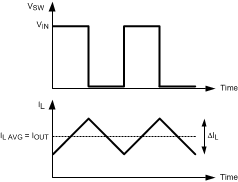ZHCSJU8G February 2011 – March 2022 LM21215
PRODUCTION DATA
- 1 特性
- 2 应用
- 3 说明
- 4 Revision History
- 5 Pin Configuration and Functions
- 6 Specifications
- 7 Detailed Description
- 8 Application and Implementation
- 9 Layout
- 10Device and Documentation Support
- 11Mechanical, Packaging, and Orderable Information
8.2.1.2.5 Inductor Selection
The inductor (L) used in the application influences the ripple current and the efficiency of the system. The first selection criteria is to define a ripple current, ΔIL. In a buck converter, it is typically selected to run between 20% to 30% of the maximum output current. Figure 8-5 shows the ripple current in a standard buck converter operating in continuous conduction mode. Larger ripple current results in a smaller inductance value, which will lead to a lower series resistance in the inductor and improved efficiency. However, larger ripple current will also cause the device to operate in discontinuous conduction mode at a higher average output current.
 Figure 8-5 Switch And Inductor Current Waveforms
Figure 8-5 Switch And Inductor Current WaveformsOnce the ripple current has been determined, the appropriate inductor size can be calculated using Equation 5:
